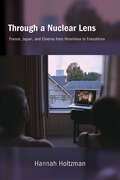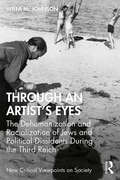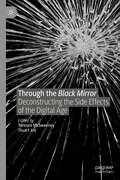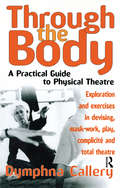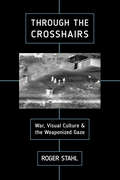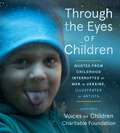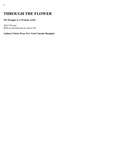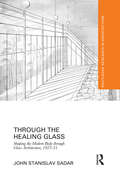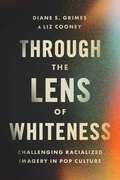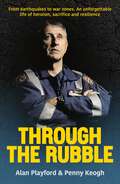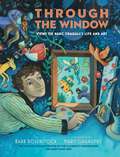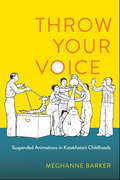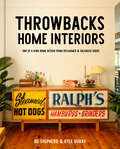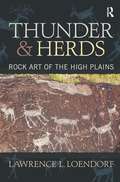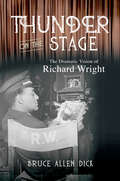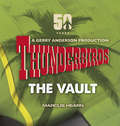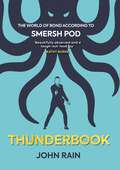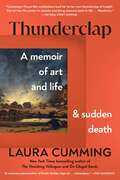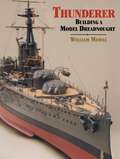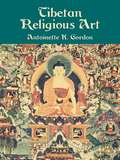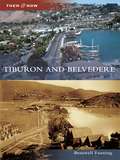- Table View
- List View
Through a Nuclear Lens: France, Japan, and Cinema from Hiroshima to Fukushima (SUNY series, Horizons of Cinema)
by Hannah HoltzmanThe Franco-Japanese coproduction Hiroshima mon amour (1959) is one of the most important films for global art cinema and for the French New Wave. In Through a Nuclear Lens, Hannah Holtzman examines this film and the transnational cycle it has inspired, as well as its legacy after the 2011 nuclear disaster at Fukushima Daiichi. In a study that includes formal and theoretical analysis, archival research, and interviews, Holtzman shows the emergence of a new kind of nuclear film, one that attends to the everyday effects of nuclear disaster and its impact on our experience of space and time. The focus on Franco-Japanese exchange in cinema since the postwar period reveals a reorientation of the primarily aesthetic preoccupations in the tradition of Japonisme to center around technological and environmental concerns. The book demonstrates how French filmmakers, ever since Hiroshima mon amour, have looked to Japan in part to better understand nuclear uncertainty in France.
Through an Artist's Eyes: The Dehumanization and Racialization of Jews and Political Dissidents During the Third Reich
by Willa M. JohnsonThis book offers visual, social-historical analyses of paintings and drawings of the renowned German Communist artist Karl Schwesig. It follows the course of Schwesig’s internments, but is dedicated primarily to the plight of foreign Jewish persons and Christians (of Jewish descent) who were interned at Camps Saint-Cyprien, Gurs, and Noé in the French free zone. The artworks created by Schwesig provide the themes investigated in each chapter. The works describe the dehumanizing treatment that contributed to and characterized the racialization of foreign Jewish and “mixed-race” persons in France’s free zone and the attempted elimination of political dissidents. The volume includes color plates.
Through the Black Mirror: Deconstructing the Side Effects of the Digital Age
by Stuart Joy Terence McSweeneyThis edited collection charts the first four seasons of Black Mirror and beyond, providing a rich social, historical and political context for the show. Across the diverse tapestry of its episodes, Black Mirror has both dramatized and deconstructed the shifting cultural and technological coordinates of the era like no other. With each of the nineteen chapters focussing on a single episode of the series, this book provides an in-depth analysis into how the show interrogates our contemporary desires and anxieties, while simultaneously encouraging audiences to contemplate the moral issues raised by each episode. What if we could record and replay our most intimate memories? How far should we go to protect our children? Would we choose to live forever? What does it mean to be human? These are just some of the questions posed by Black Mirror, and in turn, by this volume. Written by some of the foremost scholars in the field of contemporary film and television studies, Through the Black Mirror explores how Black Mirror has become a cultural barometer of the new millennial decades and questions what its embedded anxieties might tell us.
Through the Body: A Practical Guide to Physical Theatre
by Dymphna CalleryIn Through the Body, Dymphna Callery introduces the reader to the principles behind the work of key practitioners of 20th-century theater including Artaud, Grotowski, Brook and Lecoq. She offers exercises that turn their theories into practice and explore their principles in action.
Through the Crosshairs: War, Visual Culture, and the Weaponized Gaze (War Culture)
by Roger StahlNow that it has become so commonplace, we rarely blink an eye at camera footage framed by the crosshairs of a sniper’s gun or from the perspective of a descending smart bomb. But how did this weaponized gaze become the norm for depicting war, and how has it influenced public perceptions? Through the Crosshairs traces the genealogy of this weapon’s-eye view across a wide range of genres, including news reports, military public relations images, action movies, video games, and social media posts. As he tracks how gun-camera footage has spilled from the battlefield onto the screens of everyday civilian life, Roger Stahl exposes how this raw video is carefully curated and edited to promote identification with military weaponry, rather than with the targeted victims. He reveals how the weaponized gaze is not only a powerful propagandistic frame, but also a prime site of struggle over the representation of state violence.
Through the Eyes of Children: Quotes from Childhood Interrupted by War in Ukraine, Illustrated by Artists
by Voices of Charitable FoundationA heartrending and beautiful trilingual book that gives voice to the children of war-torn Ukraine, interspersed with moving works of art.What is it like to be a child living in a country under siege—or living in a foreign city or land far from everything you have known and loved? In this moving and unforgettable book, Ukraine’s children speak out about growing up in amid the violence, terror, and death of war. Through the Eyes of Children is a collection of children’s quotes paired with evocative color artwork. Each quote appears in Cyrillic, transliterated Ukrainian, and English, making the book a tool for both language learning and language preservation.Each copy sold funds a week’s mental health assistance for a Ukrainian child.
Through the Eyes of a Dancer: Selected Writings
by Wendy PerronThrough the Eyes of a Dancer compiles the writings of noted dance critic and editor Wendy Perron. In pieces for The SoHo Weekly News, Village Voice, The New York Times, and Dance Magazine, Perron limns the larger aesthetic and theoretical shifts in the dance world since the 1960s. She surveys a wide range of styles and genres, from downtown experimental performance to ballets at the Metropolitan Opera House. In opinion pieces, interviews, reviews, brief memoirs, blog posts, and contemplations on the choreographic process, she gives readers an up-close, personalized look at dancing as an art form. Dancers, choreographers, teachers, college dance students—and anyone interested in the intersection between dance and journalism—will find Perron's probing and insightful writings inspiring. Through the Eyes of a Dancer is a nuanced microcosm of dance's recent globalization and modernization that also provides an opportunity for new dancers to look back on the traditions and styles that preceded their own.
Through the Flower: My Struggle as a Woman Artist
by Judy ChicagoIt is 1993; nearly fifty years since I began studying art; over thirty-five years since I left the city of my birth to go to college in California; almost thirty years since I had my first solo show; even longer than that since my first husband died; fourteen years since my second husband, Lloyd, and I divorced; and over seven years since I remarried. (They say three’s a charm, and my marriage to photographer Donald Woodman seems to be proving this proverb true.)
Through the Healing Glass: Shaping the Modern Body through Glass Architecture, 1925-35 (Routledge Research in Architecture)
by John Stanislav SadarIn the mid-1920s a physiologist, a glass chemist, and a zoo embarked on a project which promised to turn buildings into medical instruments. The advanced chemistry of "Vita" Glass mobilised theories of light and medicine, health practices and glassmaking technology to compress an entire epoch’s hopes for a healthy life into a glass sheet – yet it did so invisibly. To communicate its advantage, Pilkington Bros. spared no expense as they launched the most costly and sophisticated marketing campaign in their history. Engineering need for "Vita" Glass employed leading-edge market research, evocative photography and vanguard techniques of advertising psychology, accompanied by the claim: "Let in the Health Rays of Daylight Permanently through "Vita" Glass Windows." This is the story of how, despite the best efforts of two glass companies, the leading marketing firm of the day, and the opinions of leading medical minds, "Vita" Glass failed. However, it epitomised an age of lightness and airiness, sleeping porches, flat roofs and ribbon windows. Moreover, through its remarkable print advertising, it strove to shape the ideal relationship between our buildings and our bodies.
Through the Lens of Whiteness: Challenging Racialized Imagery in Pop Culture
by Diane S. Grimes Liz CooneyAn essential resource for anyone who wants to enter the next stage of their antiracist journey—recognizing, analyzing, and confronting the perpetuation of racism in our visual world.Images in the news, social media, advertisements, memes, websites, and selfies shape how we understand ourselves, our society, and our world. Even the images we don’t see have an impact on our daily lives. But images are not innocent. And we don’t have to be passive consumers. Our racial identities, assumptions, histories, and biases filter the images we absorb and affect how we interpret them. Are they problematic? How can you tell? Why should you care?Situated at the intersection of critical whiteness theory and visual culture, Through the Lens of Whiteness: Challenging Racialized Imagery in Pop Culture teaches readers visual literacy tools that expose racist messages, conventions, and symbols in images. Authors Diane S. Grimes and Liz Cooney help readers understand these patterns more deeply with detailed analysis of vivid image examples and personal stories to dismantle existing biases and develop an antiracist perspective. Grimes and Cooney are guided by the principle that white people bear the responsibility for dismantling racist structures and so primarily address white readers, but also offer this book in the hope that it will be a powerful tool of resistance for all readers.
Through the Negative: The Photographic Image and the Written Word in Nineteenth-Century American Literature
by Megan WilliamsThe Civil War was the first 'image war', as photographs of the battlefields became the dominant means for capturing an epochal historical moment. At the same time, writers used the Civil War to present both their notions of nation and their ideas about the new intersections between photography and literary form. Through The Negative offers an accou
Through the Rubble: From Earthquakes to War Zones. A Story of Survival and Service
by Alan Playford Penny KeoghAn unforgettable life of heroism, sacrifice, and resilience.In Through the Rubble, Alan Playford recounts his extraordinary life, marked by the dramatic moment he emerged from the wreckage of the Newcastle Workers Club during the 1989 earthquake. Alan became a national hero after rescuing Norm Duffy from beneath the rubble. In news coverage that circled the globe, Alan embodied the courage and determination of paramedics whose lives inspire admiration. For the paramedic known as 'Scoop,' this was simply another day on the job. To those who know him best, it was his destiny. Alan has been at the heart of defining moments in Australian history and global conflict, moments that forever changed the practice of paramedicine and saved millions of lives. This gripping memoir traces Alan&’s remarkable career, from his early struggles to modernise the ambulance service and launch helicopter rescue in Australia, to his life-saving work in global conflict zones. Alan served on the frontlines in Rwanda, East Timor, and the Solomon Islands, providing aid in dangerous environments and rescuing countless lives from the brink of death. A pioneer in the field, in 1989 Alan founded the Westpac helicopter service, which has since been integral in saving lives nationally. His bravery continued during domestic crises like the 2003 Canberra bushfires, where his calm under pressure earned him Australia&’s highest honours. Alan shares dramatic moments of heroism and the emotional toll of a career spent on the frontlines. He reveals the psychological burdens borne by those who serve, offering a deep look into the personal sacrifices made to protect others. This memoir is both a thrilling account of one man&’s life of service and a testament to the resilience of the human spirit in the face of unimaginable odds. Alan Playford&’s Through the Rubble offers an unforgettable portrait of a true hero—someone whose courage, compassion, and determination have shaped paramedicine and saved countless lives, both in Australia and around the world.
Through the Window: Views of Marc Chagall's Life and Art
by Barb RosenstockA gorgeous, expressive picture-book biography of Marc Chagall by the Caldecott Honor team behind The Noisy Paint Box.Through the window, the student sees . . .His future--butcher, baker, blacksmith, but turns away.A classmate sketching a face from a book. His mind blossoms.The power of pictures. He draws and erases, dreams in color while Papa worries.A folder of pages laid on an art teacher's desk. Mama asks, Does this boy have talent?Pursed lips, a shrug, then a nod, and a new artist is welcomed. His brave heart flying through the streets, on a journey unknowable.Known for both his paintings and stained-glass windows, Marc Chagall rose from humble beginnings to become one of the world's most renowned artists. Admired for his use of color and the powerful emotion in his work, Chagall led a career that spanned decades and continents, and he never stopped growing. This lyrical narrative shows readers, through many different windows, the pre-WWI childhood and wartime experiences that shaped Chagall's path. From the same team behind the Caldecott Honor Book The Noisy Paint Box, which was about the artist Kandinksy, Through the Window is a stunning book that, through Chagall's life and work, demonstrates how art has the power to be revolutionary.
Throw Your Voice: Suspended Animations in Kazakhstani Childhoods
by Meghanne BarkerThrow Your Voice is a story of loss and recovery. It relates how children placed in a temporary care institution make sense of their situations. Moving between a Kazakhstan government children's home, Hope House, and the Almaty State Puppet Theater, Meghanne Barker shows how children, and puppets, as proxies, bring to life ideologies of childhood and visions of a rosy future. Sites and stories run in parallel. Framed by the narrative of Anton Chekhov's "Kashtanka," about a lost dog taken in by a kind stranger, the author follows the story's staging at the puppet theater. At Hope House, children find themselves on a path similar to Kashtanka, dislodged from their first homes to reside in a second.The heart of this story is about living in displacement and about the fragile intimacies achieved amidst conditions of missing. Whether due to war, migration, or pandemic, people get separated from those closest to them. Throw Your Voice examines how strangers become familiar, and how objects mediate precarious ties. She shows how people use fantasy to mitigate loss.
Throwbacks Home Interiors: One of a Kind Home Design from Reclaimed and Salvaged Goods
by Bo Shepherd Kyle DubayA stunningly photographed collection of homes featuring sustainable designs that celebrate the ingenuity of reclaimed materials and unexpected antiques, from the founders of Detroit-based furniture design brand Woodward Throwbacks.In an effort to celebrate the unique and beautiful material that is often scrapped in renovations Bo Shepherd and Kyle Dubay founded Woodward Throwbacks, which creates original furniture and home goods using reclaimed materials salvaged in Detroit. In Throwbacks Home Interiors, they dive into the creativity of home salvage, showing readers how to incorporate found and reclaimed materials into their home décor and furniture. Each chapter showcases inspiration for incorporating salvaged materials into your home in new ways, includingUpscale furnishings made from unexpected materials, like old signs turned into a credenzaWays to incorporate original hardware, flooring, or trim into any style, whether you prefer a more traditional look, a modern sleek design, or an eclectic mix.Spotlights on various materials and how to include them in your home, whether that's using a marble remnant to make a brand new countertop, turning broken tiles into a bespoke backsplash, or using offcuts of wood to create a one of a kind gorgeous side table.Tips for finding salvaged and reclaimed material as well as insights into thrifting furniture and finding old things to love in your new home.Along the way, authors Bo Shepherd and Kyle Dubay give readers the tools to bring that unique style home. For fans of historic details and homes with a story, Throwbacks Home Interiors offers plenty of inspiration for reusing, restyling, and elevating items that you find or love, matching modern with antique for a home that is stylish and personal.
Thunder and Herds: Rock Art of the High Plains
by Lawrence L. LoendorfAnthropologist and archaeologist Loendorf explores the remarkable ancient Indian petroglyphs (rock art) of southeastern Colorado's High Plains. The author surveys numerous rock art sites and places them in both temporal and archaeological perspectives, and interprets the frequently abstract forms this style of art often takes. The book will appeal to anyone with an interest in archaeology, American Indians, rock art, and the High Plains canyon country. It contains several illustrations and photographs. Annotation ©2009 Book News, Inc. , Portland, OR (booknews. com)
Thunder on the Stage: The Dramatic Vision of Richard Wright
by Bruce Allen DickRichard Wright’s dramatic imagination guided the creation of his masterpieces Native Son and Black Boy and helped shape Wright’s long-overlooked writing for theater and other performative mediums. Drawing on decades of research and interviews with Wright’s family and Wright scholars, Bruce Allen Dick uncovers the theatrical influence on Wright’s oeuvre--from his 1930s boxing journalism to his unpublished one-acts on returning Black GIs in WWII to his unproduced pageant honoring Vladimir Lenin. Wright maintained rewarding associations with playwrights, writers, and actors such as Langston Hughes, Theodore Ward, Paul Robeson, and Lillian Hellman, and took particular inspiration from French literary figures like Jean-Paul Sartre. Dick’s analysis also illuminates Wright’s direct involvement with theater and film, including the performative aspects of his travel writings; the Orson Welles-directed Native Son on Broadway; his acting debut in Native Son’s first film version; and his play “Daddy Goodness,” a satire of religious charlatans like Father Divine, in the 1930s. Bold and original, Thunder on the Stage offers a groundbreaking reinterpretation of a major American writer.
Thunderbirds: The Vault: celebrating over 50 years of the classic series
by Marcus HearnCelebrating over 50 years of the classic TV series, this beautiful, lavish hardback written by Thunderbirds expert Marcus Hearn. Contains exclusive, never before published behind the scenes material and interviews with cast and crew and tells the story of one of this enduring cult phenomenon. Thunderbirds are GO! 'A most enjoyable step back in time!' -- ***** Reader review'You can never have enough Thunderbirds' -- ***** Reader review'CHOCK FULL of pretty much everything there is to know about Thunderbirds' -- ***** Reader review'Unputdownable' -- ***** Reader review'If you are a fan, this is the ONE BOOK you must not miss out on' -- ***** Reader review'A treasure' -- ***** Reader review'Beautiful book full of all the information a real fan needs' -- ***** Reader review'F.A.B. (FLIPPING ACTUALLY BRILLIANT)' -- ***** Reader review***********************************************************************************************On 30th September 1965, International Rescue successfully completed their first assignment, and the Tracy brothers imprinted themselves on a generation of captivated children.Thirty-two episodes, many repeats, sixty territories, two feature films, three albums, numerous comics, books, toys, videos and DVDs and over five decades later, Thunderbirds are still saving the world from the brink of peril.Thunderbirds: The Vault will be the first ever lavishly illustrated, definitive, beautifully packaged, presentation hardback telling the story of this enduring cult phenomenon.Packed with previously unpublished material, including prop photos, design sketches, production memos and other collectible memorabilia, plus specially commissioned photography of original 60s merchandise, and new interviews with cast and crew, this is a collectors' dream and a fantastic piece of British TV history.
Thunderbook: The World of Bond According to Smersh Pod
by John RainThe creator of SMERSH Pod explores his favorite Bond films (and the other ones, too) in this irreverent celebration of the spy thriller franchise. The Bond films have entertained annoyed, excited, bored, aroused and invigorated moviegoers for generations. Who hasn&’t wanted to kick a big bloke with metal teeth in the groin? Fly a small plane out of a pretend horse&’s bottom? Or push a middle-aged man into space? No one, that&’s who. John Rain, host of the Bond podcast SMERSH Pod, affectionately examines Bond with tongue firmly in cheek in Thunderbook. With a chapter devoted to every Bond film from Dr. No to Spectre, Thunderbook examines all the moments that are funny, silly, rubbish, nonsensical, bizarre and interesting. An irreverent celebration of Agent 007, this is the go-to companion book for Bond fans.
Thunderclap: A Memoir of Art and Life and Sudden Death
by Laura CummingNew York Times bestselling author and art critic Laura Cumming reveals the fascinating, little-known story of the Thunderclap—the massive explosion at a gunpowder store in Holland that killed Carel Fabritius, renowned painter of The Goldfinch and nearly killed Johannes Vermeer, painter of Girl with a Pearl Earring—two of the greatest artists of the 17th century.As a brilliant art critic and historian, Laura Cumming has explored the importance of art in life and can give us a perspective on the time and place in which the artist worked. Now, through the lens of one dramatic event in 17th century Holland, Cumming illuminates one of the most celebrated periods in art history. In 1654, an enormous explosion at a gunpowder store devasted the city of Delft, killing hundreds of people and injuring thousands more. Among those killed was the extraordinary painter Carel Fabritius, renowned for his paintings The Goldfinch and his haunting masterpiece A View of Delft, which depicts the very streets through which the victims would be carried to their graves. Fabritius&’s contemporary and rival Vermeer, painter of the iconic portrait Girl with a Pearl Earring, narrowly escaped death. Framing the story around Fabritius&’s life, Cumming deftly weaves a sequence of observations about paintings and how they relate to everyday life. Like Dutch art itself, the story gradually links country, city, town, street, house, interior—all the way to the bird on its perch, the blue and white tile, the smallest seed in a loaf of bread. The impact of a painting and how it can enter our thoughts, influence our views, and understanding of the world is the heart of this book and Cumming has brought her unique eye to her most compelling subject yet. Featuring beautiful full-color images of Dutch paintings throughout, this is a stunningly rich book about one of the most vibrant periods in European art and life.
Thunderer: Building a Model Dreadnought
by William MowllThe expert ship modeler&’s a step-by-step guide to building a large-scale model of the dreadnaught that fought in the WWI Battle of Jutland. Laid down in April of 1910, HMS Thunderer was the last Orion-class dreadnaught battleship built for the Royal Navy. The author&’s 1/96 scale museum-quality model of this ship brings to life the power and potency of the Super Dreadnoughts. In this comprehensive guide, every aspect of model building is covered, from the hull to wireless equipment. All the different techniques required to bring a complex model battleship to completion are thoroughly explained, including casting in metal and GRP, silver brazing, soft soldering, metal fabrication in steel, brass, copper, aluminum and pewter, and lathe turning and milling operations for the production of guns and propellers. The author also covers the contemporary American battleship, USS Texas, the only remaining ship of that type and era, and an inspiration for any modeler setting out to tackle this subject. Not just a how-to manual, the book is also an eloquent testimony to the skills of the designers and the original builders as well as a wonderful evocation of the great ships that fought at the Battle of Jutland.
Tibetan Calligraphy
by Sarah Harding Sanje ElliottIn Tibetan Calligraphy, Sanje Elliott shows us how to capture the elegance and grace of Tibetan calligraphy without prior knowledge of either Tibetan language or calligraphy. This beautiful book includes many prayers, mantras, and seed syllables to copy and study. Perfect for practitioners, artists, and anyone interested in the Tibetan language.
Tibetan Religious Art
by Antoinette K. GordonOver 50 years after its first publication this work remains a vital and useful survey. Assembled by an anthropologist at the American Museum of Natural History, it features artwork from that institution's extensive collections, in addition to seldom-seen Tibetan artifacts from other museums and private collections. Following an informative overview of the intrinsic relationship of Buddist deities to Tibetan art, a lavish assortment of illustrations includes temple paintings, books, wood blocks, ritual objects, robes, masks, metal work, musical instruments, jewelry, butter sculpture, sand mandalas, and calligraphy. Each item is described in detail, with explanations of the methods and materials used in its creation. Preface. Bibliography. Index. 92 black-and-white illustrations.
Tiburon and Belvedere
by Branwell FanningTiburon and Belvedere share the same spectacular peninsula jutting into San Francisco Bay from Marin County, California. With water on three sides, fabulous views everywhere, and San Francisco a 30-minute ferry ride away, these two communities have become highly desirable places to live. Historian Branwell Fanning, twice mayor of Tiburon, using his own collection and the archives of the Belvedere/Tiburon Landmarks Society, describes the area's transition from dairy ranches, railroad yards, military bases, and cod fisheries, to charming villages filled with homeowners.
Tick... Tick... Tick...: The Long Life and Turbulent Times of Sixty Minutes
by David BlumAn insider's view of the most successful show in the history of TV, 60 Minutes. The most popular TV show in America isn't American Idol, and it's not Survivor. Month in, month out, the most–watched program in America is 60 Minutes, drawing a staggering 25 million viewers in an average week. For its entire 34–year history, 60 Minutes was the brainchild (and personal fiefdom) of Don Hewitt, the take–no–prisoners visionary who hustled the show into being and kept it afloat with a mixture of chutzpah, tough talk, scheming, and journalistic savvy. But now that Hewitt is 80 and grudgingly considering retirement, the show's direction is increasingly up for grabs, and the transition will surely be marked by some serious fireworks. As author David Blum provides a fly–on–the–wall perspective on the show's upheavals, he'll also trace its past; although the show has aired some 5,000 pieces and has made household names of Mike Wallace, Ed Bradley, Leslie Stahl, and Morley Safer, much of the backstage story––the passionate pursuit of stories, the behind–the–scenes wrangling, and the stars' prima donnish behavior––has gone untold. With full access to the producers, stars, and executives, Blum will give readers an unprecedented view of the personalities and events that have shaped 60 Minutes – and a new perspective on how current events become news.
